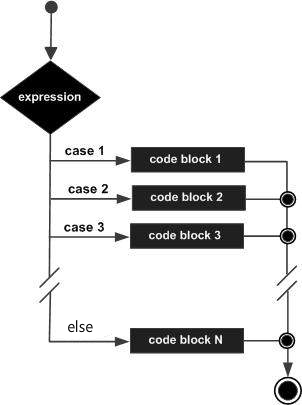Perl switch statement
Test case aswitch statement allows a variable equal to the multiple value.Each value is called a case, and the variable will be tested eachswitch case to be checked.
Switch Executive switch case is based on the module, Switchmodule usesFilter :: Util :: CallandText :: Balancedto perform, both modules need to be installed.
grammar
The syntax is as follows:
use Switch;
switch(argument){
case 1 { print "数字 1" }
case "a" { print "字符串 a" }
case [1..10,42] { print "数字在列表中" }
case (\@array) { print "数字在数组中" }
case /\w+/ { print "正则匹配模式" }
case qr/\w+/ { print "正则匹配模式" }
case (\%hash) { print "哈希" }
case (\&sub) { print "子进程" }
else { print "不匹配之前的条件" }
}
The following are the rules of the switch statement:
- bracketsswitch statement can be used in any type of scalar parameters.
In a switch you can have any number of case statements. Each case is followed by a value to compare with a colon.
Scalar case statement, then the scalar will switch statement, and determines whether or not the same.
When the variable being tested is equal to the case of constant time, followed by a case statement will be executed, until it encounters abreak statement.
switch statement can have an optional else,the statement in the final surface, the statement is executed in the case does not match any case.
When the matching case, case statement block executes code out of the switch statement after executing.
When the matching case, if we need to continue to execute the next case statement, you need to add thenext statement.
flow chart

Examples
#!/usr/bin/perl
use Switch;
$var = 10;
@array = (10, 20, 30);
%hash = ('key1' => 10, 'key2' => 20);
switch($var){
case 10 { print "数字 10\n" }
case "a" { print "字符串 a" }
case [1..10,42] { print "数字在列表中" }
case (\@array) { print "数字在数组中" }
case (\%hash) { print "在哈希中" }
else { print "没有匹配的条件" }
}
The above program, the output is:
数字 10
Next we look at the use ofnext instance:
#!/usr/bin/perl
use Switch;
$var = 10;
@array = (10, 20, 30);
%hash = ('key1' => 10, 'key2' => 20);
switch($var){
case 10 { print "数字 10\n"; next; } # 匹配后继续执行
case "a" { print "string a" }
case [1..10,42] { print "数字在列表中" }
case (\@array) { print "数字在数组中" }
case (\%hash) { print "在哈希中" }
else { print "没有匹配的条件" }
}
The above program, the output is:
数字 10 数字在列表中
